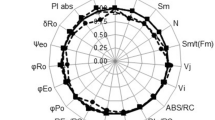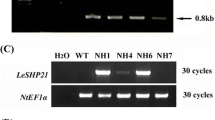Abstract
A known sweet pepper cDNA clone, CaHSP26 encoding the chloroplast-localized small heat shock protein (CPsHSP), was isolated and introduced into tobacco plants. It has been reported that CaHSP26 is a member of the CPsHSP gene family related to extreme temperature tolerance in plants. In the present work, the transcripts were detected in the transgenic tobacco lines. The actual quantum yield of photosynthesis (ΦPSII), non-photochemical quenching, and stomatal conductance (gs) in the transgenic lines overexpressing CaHSP26 were higher than those in the wild-type plants under a range of photosynthetic photon flux density during chilling stress. Electron microscopic analysis showed that the transgenic line (L1) had larger size of stomata to lessen stomatal limitation. The activities of ascorbate peroxidase (APX), peroxidase (POD) and catalase (CAT) were also higher in the transgenic lines than those in wild-type plants. Additionally, a significant increase in cis-unsaturated fatty acid contents was observed in transgenic lines due to lower temperatures. These results suggested that CaHSP26 protein plays an important role in protection of PSII by maintaining the antioxidative enzyme activities to avoid or mitigate photooxidation and increasing the fluidity of the thylakoid membrane during chilling stress under low irradiance.
Key message CaHSP26 protein protects PSII by maintaining the antioxidative enzyme activities to avoid or mitigate photooxidation and increases the fluidity of the thylakoid membrane during chilling stress under low irradiance.






Similar content being viewed by others
References
Aebi H (1984) Catalase in vitro. Methods Enzymol 105:121–126
Allen DJ, Ort DR (2001) Impacts of chilling temperatures on photosynthesis in warm-climate plants. Trends Plant Sci 6:36–42
Al-Whaibi MH (2011) Plant heat-shock proteins: a mini review. J King Saud Univ (Sci) 23:139–150
Apel K, Hirt H (2004) Reactive oxygen species: metabolism, oxidative stress, and signal transduction. Annu Rev Plant Biol 55:373–399
Bartoli CG, Simontacchi M, Tambussi E, Beltrano J, Montaldi E, Puntarulo S (1999) Drought and watering-dependent oxidative stress: effect on anti-oxidant content in Triticum aestivum L. leaves. J Exp Bot 50:375–383
Basha E, Jones C, Wysocki V, Vierling E (2010) Mechanistic differences between two conserved classes of small heat shock proteins found in the plant cytosol. J Biol Chem 285:11489–11497
Boston RS, Viitanen PV, Vierling E (1996) Molecular chaperones and protein folding in plants. Plant Mol Biol 32:191–222
Delong EF, Yayanos AA (1985) Adaptation of the membrane lipids of a deep-sea bacterium to changes in hydrostatic pressure. Science 228:1101–1102
Foyer CH, Vanacker H, Gom′ ez LG, Harbinson J et al (2002) Regulation of photosynthesis and antioxidant metabolism in maize leaves at optimal and chilling temperatures: review. Plant Physiol Biochem 40:659–668
Gao JP, Chao DY, Lin HX (2008) Toward understanding molecular mechanisms of abiotic stress responses in rice. Rice 1:36–51
Guo SJ, Zhou HY, Zhang XS, Li XG, Meng QW (2007) Overexpression of CaHSP26 in transgenic tobacco alleviates photoinhibition of PSII and PSI during chilling stress under low irradiance. J Plant Physiol 164:126–136
Harrison EP, Willingham NM, Lloyd JC, Raines CA (1998) Reduced sedoheptulose-1,7-bisphosphatase levels in transgenic tobacco lead to decreased photosynthetic capacity and altered carbohydrate accumulation. Planta 204:27–36
Haslbeck M, Walke S, Stromer T, Ehrnsperger M, White HE, Chen S, Saibil HR, Bucher J (1999) Hsp26: a temperature-regulated chaperone. EMBO J 18:6744–6751
Hincha DK (2008) Effects of α-tocopherol (vitamin E) on the stability and lipid dynamics of model membranes mimicking the lipid composition of plant chloroplast membranes. FEBS Lett 582:687–3692
Hodges DM, Andrews CJ, Johnson DA, Hamilton RI (1997) Antioxidant enzyme and compound responses to chilling stress and their combining abilities in differentially sensitive maize hybrids. Crop Sci 34:857–883
Jahnke LS, Hull MR, Long SP (1991) Chilling stress and oxygen metabolizing enzymes in Zea mays and Zea diploperennis. Plant Cell Environ 14:97–104
Jiang C, Xu J, Zhang H, Zhang X, Shi J, Li M, Ming F (2009) A cytosolic class I small heat shock protein, RcHSP17.8, of Rosa chinensis confers resistance to a variety of stresses to Escherichia coli, yeast and Arabidopsis thaliana. Plant Cell Environ 32:1046–1059
Kim DH, Xu ZY, Na YJ, Yoo YJ, Lee J, Sohn EJ, Hwang I (2011) Small heat shock protein Hsp17.8 functions as an AKR2A cofactor in the targeting of chloroplast outer membrane proteins in Arabidopsis. Plant Physiol 157:132–146
Kingston-Smith AH, Harbinson J, Williams J, Foyer CH (1997) Effect of chilling on carbon assimilation, enzyme activation, and photosynthetic electron transport in the absence of photoinhibition in maize leaves. Plant Physiol 114:1039–1046
Lawlor DW (2002) Limitation to photosynthesis in water-stress leaves: stomata vs metabolism and the role of ATP. Ann Bot 89:871–885
Lester EG, Hodges MD, Meyer DR, Munro DK (2004) Pre-extraction preparation (fresh, frozen, freeze-dried, or acetone powdered) and long-term storage of fruit and vegetable tissues: effects on antioxidant enzyme activity. J Agric Food Chem 52:2167–2173
Li XG, Meng QW, Jiang GQ, Zou Q (2003) The susceptibility of cucumber and sweet pepper to chilling under low irradiance is related to energy dissipation and water–water cycle. Photosynthetica 41:259–265
Lynch DV, Thompson GA (1982) Low temperature-induced alterations in the chloroplast and microsomal membranes of Dunaliella salina. Plant Physiol 69:1369–1375
Lyons JM (1973) Chilling injury in plants. Annu Rev Plant Physiol 24:445–466
Ma QQ, Wang W, Li YH, Li DQ, Zou Q (2006) Alleviation of photoinhibition in drought-stressed wheat (Triticum aestivum) by foliar-applied glycinebetaine. J Plant Physiol 163:165–175
Meer GV, Voelker DR, Feigenson GW (2008) Membrane lipids: where they are and how they behave. Nat Rev Mol Cell Biol 9:112–124
Mu CJ, Wang SB, Zhang SJ, Pan JJ, Chen N, Li XF, Wang ZY, Liu H (2011) Small heat shock protein LimHSP16.45 protects pollen mother cells and tapetal cells against extreme temperatures during late zygotene to pachytene stages of meiotic prophase I in David Lily. Plant Cell Rep 30:1981–1989
Murata N, Ishizaki-Nishizawa O, Higashi S, Hayashi H, Tasaka Y, Nishida I (1992) Genetically engineered alteration in the chilling sensitivity of plants. Nature 356:710–713
Nakano Y, Asada K (1981) Hydrogen peroxide is scavenged by ascorbate peroxidase in spinach chloroplasts. Plant Cell Physiol 22:867–880
Neta-Sharir I, Isaacson T, Lurie S, Weiss D (2005) Dual role for tomato heat shock protein 21: protecting photosystem II from oxidative stress and promoting color changes during fruit maturation. Plant Cell 17:1829–1838
Nishida I, Murata N (1996) Chilling sensitivity in plants and cyanobacteria: the crucial contribution of membrane lipids. Annu Rev Plant Physiol 47:541–568
Prasad KVSK, Pardha SP (2004) Enhance tolerance to photoinhibition in transgenic plants through targeting of glycinebetaine biosynthesis into chloroplasts. Plant Sci 166:1197–1212
Qi Y, Wang H, Zou Y, Liu C, Liu Y, Wang Y, Zhang W (2011) Overexpression of mitochondrial heat shock protein 70 suppresses programmed cell death in rice. FEBS Lett 585:231–239
Quan R, Shang M, Zhang H, Zhao Y, Zhang J (2004) Improved chilling tolerance by transformation with betA gene for the enhancement of glycinebetaine synthesis in maize. Plant Sci 166:141–149
Sabehat A, Weiss D, Lurie S (1996) The correlation between heat shock protein accumulation and persistence and chilling tolerance in tomato fruit. Plant Physiol 110:531–537
Saidi Y, Peter P, Finka A, Cicekli C, Vígh L, Goloubinoff P (2010) Membrane lipid composition affects plant heat sensing and modulates Ca2+-dependent heat shock response. Plant Signal Behav 5:1530–1533. doi:10.4161/psb.5.12.13163
Saidi Y, Finka A, Goloubinoff P (2011) Heat perception and signalling in plants: a tortuous path to thermotolerance. New Phytol 190:556–565
Sawa K, Teigo A, Yoshinori F, Shiro K (2008) Anti-herbivore structures of Paulownia tomentosa: morphology, distribution, chemical constituents and changes during shoot and leaf development. Ann Bot 101:1035–1047
Scebba F, Sebastiani L, Vitagliano C (2001) Activities of antioxidant enzymes during senescence of Prunus armeniaca leaves. Bio. Plant 44:41–46
Soto A, Allona I, Collada C, Guevara MA, Casado R, Cerezo ER, Aragoncillo C, Gomez L (1999) Heterologous expression of a plant small heat shock protein enhances Escherichia coli viability under heat and cold stress. Plant Physiol 120:521–528
Sun LP, Liu Y, Kong XP, Zhang D, Pan JW, Zhou Y, Wang L, Li DQ, Yang XH (2012) ZmHSP16.9, a cytosolic class I small heat shock protein in maize (Zea mays), confers heat tolerance in transgenic tobacco. Plant Cell Rep. doi:10.1007/s00299-012-1262-8
Suzuki I, Los DA, Murata N (2000) Perception and transduction of low temperature signals to induce desaturation of fatty acids. Biochem Soc Trans 28:628–630
Teixeira FK, Menezes-Benavente L, Galvao VC, Margis R, Margis-Pinheiro M (2006) Rice ascorbate peroxidase gene family encodes functionally diverse isoforms localized in different subcellular compartments. Planta 224:300–314
Timperio AM, Egidi MG, Zolla L (2008) Proteomics applied on plant abiotic stresses: role of heat shock proteins (HSP). J Proteomics 71:391–411
Tripp J, Mishra SK, Scharf KD (2009) Functional dissection of the cytosolic chaperone network in tomato mesophyll protoplasts. Plant Cell Environ 32:123–133
Tsien HC, Dreyfus BL, Schmidt EL (1983) Initial stages in the morphogenesis of nitrogen-fixing stem nodules of Sesbania rostrata. J Bacteriol 156:888–897
von Caemmerer S, Farquhar GD (1981) Some relationships between the biochemistry of photosynthesis and the gas exchange of leaves. Planta 153:376–387
Wang SY, Faust M (1990) Seasonal changes of membrane lipids in apple shoots. J Am Soc Hort Sci 115:462–467
Wang SY, Lin HS (2006) Effect of plant growth temperature on membrane lipids in strawberry (Fragaria ananassa Duch.). Sci Hortic 108:35–42
Wang SY, Sun T, Whitaker BD, Faust M (1988) Effect of paclobutrazol on membrane lipids in apple seedlings. Physiol Plant 73:560–564
Wang W, Vinocur B, Shoseyov O, Altman A (2004) Role of plant heat-shock proteins and molecular chaperones in the abiotic stress response. Trends Plant Sci 9:244–252
Waters ER, Lee GJ, Vierling E (1996) Evolution, structure and function of the small heat shock proteins in plants. J Exp Bot 47:325–338
Williams JP, Khan MU, Mitchell K (1983) Galactolipid biosynthesis in leaves of 16:3- and 18:3-plants. In: Thomson WW, Mudd JB, Gibbs M (eds) Biosynthesis and function of plant lipids. American Society of Plant Physiology Symposium in Botany Riverside, California, pp 28–39
Yang XH, Liang Z, Wen XG, Lu CM (2008) Genetic engineering of the biosynthesis of glycinebetaine leads to increased tolerance of photosynthesis to salt stress in transgenic tobacco plants. Plant Mol Biol 66:73–86
Yang JS, Wang R, Meng JJ, Bi YP, Xu PL, Guo F, Wan SB, He QW, Li XG (2010) Overexpression of Arabidopsis CBF1 gene in transgenic tobacco alleviates photoinhibition of PSII and PSI during chilling stress under low irradiance. J Plant Physiol 167:534–539
Yoshimura K, Miyao K, Gaber A, Takeda T, Kanaboshi H, Miyasaka H et al (2004) Enhancement of stress tolerance in transgenic tobacco plants overexpressing Chlamydomonas glutathione peroxidase in chloroplasts or cytosol. Plant J 37:21–33
Zou J, Liu CF, Chen XB (2011) Proteomics of rice in response to heat stress and advances in genetic engineering for heat tolerance in rice. Plant Cell Rep 30:2155–2165
Acknowledgments
This research was supported by the Natural Science Foundation of China (30671242).
Author information
Authors and Affiliations
Corresponding author
Additional information
Communicated by P. Lakshmanan.
Rights and permissions
About this article
Cite this article
Li, M., Ji, L., Yang, X. et al. The protective mechanisms of CaHSP26 in transgenic tobacco to alleviate photoinhibition of PSII during chilling stress. Plant Cell Rep 31, 1969–1979 (2012). https://doi.org/10.1007/s00299-012-1309-x
Received:
Revised:
Accepted:
Published:
Issue Date:
DOI: https://doi.org/10.1007/s00299-012-1309-x




